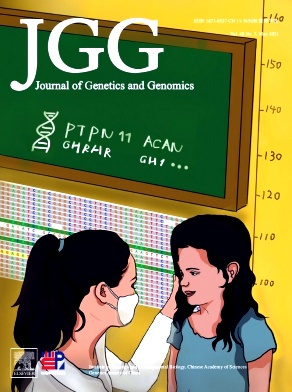主要栏目
人类与医学遗传学;动物遗传学;植物遗传学;微生物遗传学;综述
收录与荣誉
文摘与引文数据库医学文摘国家图书馆馆藏Pж(AJ) 文摘杂志(俄)CA 化学文摘(美)SCI 科学引文索引(美)JST 日本科学技术振兴机构数据库(日)知网收录CSCD 中国科学引文数据库来源期刊维普收录文摘杂志上海图书馆馆藏万方收录 中国百种杰出学术期刊中国期刊方阵双百期刊Journal of Genetics and Genomics投稿指南
Journal of Genetics and Genomics杂志投稿须知:Title pageInclude the following information on this page:? Title The full manuscript title should be succinct, informative and descriptive. The title should include detail for indexing and should be comprehensible for a broad scientific audience. Authors should avoid using nonstandard abbreviations in titles. The title must mention the subject organism (or general group in the case of comparative work). Latin names should be used for all organisms, while common names are allowed for the model systems (rice, maize and yeast).? Author affiliation Include department, institution, and complete address for each author. If there are authors with different affiliations, use superscripts to match authors with different institutions. ? Corresponding author The name, complete address, telephone and fax numbers, and e-mail address of the corresponding author should be provided. ? Manuscript information The numbers of text pages (including references and figure legends), of figures, of tables, and of words in the paper should be provided.? Word and character counts The number of words in the abstract and the total number of characters in the paper should be provided. ? Abbreviation footnote List abbreviations in alphabetical order used five or more times . Define these where first mentioned in the text and do not use them in the title.Abstract and keywords The abstract should stand on its own with no reference to the text. It should contain approximately 200 words and must summarize the questions being addressed, the approach taken, the major findings, and the significance of the results. It should be concise, complete, and clearly communicate the importance of the work for a broad audience. At least three key words (for the purposes of indexing) should be supplied following the abstract.TextAuthors should divide their manuscripts into the following sections: Introduction, Results, Discussion, and Materials and methods. Mark every section and every subsection with serial number, like
1、, 。
2、, 。
3、, and then 1、1、, 1、2、, 1、3 and so on.? Introduction The Introduction should provide the necessary background information for the average reader; it should be both complete and concise. Previous publications that form a basis for the work presented must be cited. Citation of reviews is not a substitute for citing primary research articles. Citation of recent research articles is not a substitute for citing original discoveries. An author’s own work should not be cited preferentially over equally relevant work of others. ? Results The Results should be organized using subheadings to make clear.? Discussion The Discussion should focus on the interpretation rather than a repetition of the Results section. ? Materials and Methods Methods must be described completely enough so that other laboratories can replicate results and verify claims. Generally, standard procedures should be referenced, though significant variations should be described. Appropriate experimental design and statistical methods should be applied and described wherever necessary for proper interpretation of data and verification of claims. All novel materials and the procedures should be described in sufficient detail to allow their reproduction.AcknowledgementsList dedications, acknowledgements and funding support.References Cite references in the text by name and date of publication, but not by number. Authors are expected to proofread every citation in their reference list against the PDF or photocopy of the cited work so that the reference list is accurate with respect to spellings, symbols, italics, and subscripts/superscripts. Only published or in-press papers and books may be cited in the reference list. Citations for web sites (other than for primary literature) should be handled parenthetically in the text and not included in the reference list. Authors should test all URLs and links.It is expected that all cited publications have been read and determined to be appropriate by the authors, not merely identified by database searches. Reference to specific results should be to original research articles, not to more recent articles or reviews.A reference manager software, Endnote, Reference Manager or other similar software, is suggested to be used. Then spelling errors and fault information can be avoided. The reference format is the same as Developmental Biology.
Journal of Genetics and Genomics数据分析
影响因子:指该期刊近两年文献的平均被引用率,即该期刊前两年论文在评价当年每篇论文被引用的平均次数
被引半衰期:衡量期刊老化速度快慢的一种指标,指某一期刊论文在某年被引用的全部次数中,较新的一半被引论文刊载的时间跨度
他引率:期刊被他刊引用的次数占该刊总被引次数的比例用以测度某期刊学术交流的广度、专业面的宽窄以及学科的交叉程度
引用半衰期:指某种期刊在某年中所引用的全部参考文献中较新的一半是在最近多少年时段内刊载的
平均引文数:在给定的时间内,期刊篇均参考文献量,用以测度期刊的平均引文水平,考察期刊吸收信息的能力以及科学交流程度的高低
热门评论
一个月不到就录用,速度要不要这么快,但是没有审稿意见。期刊水平一般,建议着急毕业的投,好文章感觉在这里有些浪费,还可以加急的哦!还有点提高水平,希望越办越好吧。
个人感觉是首先比较幸运,遇到了负责任、高效率的编辑。其次就是要针对审稿人的意见认真修改,态度也要诚恳。此外一审虽然被拒了,但是Journal of Genetics and Genomics杂志给的意见对我后来的文章修改还是有很大帮助的。
Journal of Genetics and Genomics杂志感觉没人审稿,就是编辑直接做决定。要么直接录用(偶尔格式修改问题),要么拒稿(增刊录用),拒稿的意见都是一样的。因为不用审稿费,不愁稿源。
6月16投的稿,十八号交审稿费,期间暑假,以为希望不大,八月七号回校收到三号的退修通知,八号改好,今天收到录稿通知,比意象的顺利!忒贵了!
印刷质量特别好,肯定是正品,非常实惠,很早就听说这本书了,终于拿下,有时间学习学习,肯定有不少收获。
这是我的第一篇文章,6月11号投稿,7月15号回一审意见,两个审稿人对文章评价都很积极,一审编辑意见大修,7月28号返回,8月20号直接接收。表示编辑很nice,工作效率高。第一篇文章这么顺利,真心给了我很大的鼓励。望杂志越办越好。
.10.7网上投稿,10.22初审结束,外审一个10.24完成,灰常快,一个11.24完成,11.27退修,12.4完成,12.16完成复审,12.20完成退修,12.21现在编辑加工了,基本上就是被录用了,感觉外审提的意见很中肯,编辑老师也很认真,只要自己认真答复外审和编辑的问题,应该都能收。
整整1.5个月,终于修成正果,外审专家还是很犀利的,编辑部老师效率也很高,都给赞,哈哈!第一次投Journal of Genetics and Genomics,心里还是比较高兴的。推荐投稿!
时间比较长主要是由于其中一个审稿人没有按规定时间返回修改意见,迟了一个月,另外一个审稿人没有审,换了一个审稿人。因此时间比较长。但是录用后直接就在的第一期发表了。速度很快,编辑部老师态度非常好。非常耐心解答问题。
非常好的一个杂志,Journal of Genetics and Genomics杂志处理速度快不拖延这是很重要的,编辑部找了两个审稿人,都是领域相关,审稿人很用心的提了一些意见,由于第一次投了这个杂志,写的不是很好,但是专家非常的认真,还帮我改了一些用词不当的地方~~
